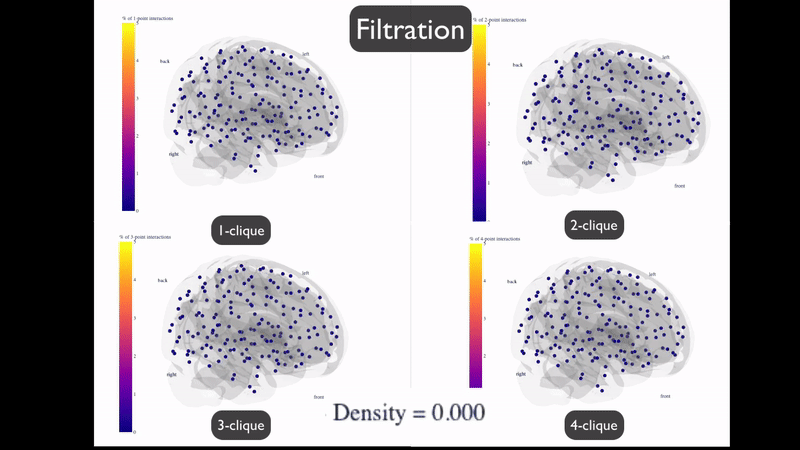Authors: Eduarda Centeno & Fernando Santos
Contact information: e.centeno@amsterdamumc.nl or f.nobregasantos@amsterdamumc.nl
The primary purpose of this project is to facilitate the computation of Network Neuroscience metrics using Graph Theory and Topological Data Analysis.
This repository is a supplement to the preprint A hands-on tutorial on network and topological neuroscience and the final version published at Brain Structure and Function.
- The first part contains the standard computations of network and TDA metrics and visualizations.
- The second part is dedicated to the 3D visualizations developed by our group.
A video created with our 3D brain plots!
Here we will describe the core packages that will be necessary, but due to dependency compatibilities, we have provided a requirements.txt with all packages needed to be installed in a new Anaconda environment.
- Python: 3.x
- Numpy: 1.18.5
- Matplotlib: 3.3.2
- Meshio: 4.0.16 --- https://pypi.org/project/meshio/
- Seaborn: 0.11.0
- Pandas: 1.1.3
- Networkx: 2.4
- Nxviz: 0.6.2 --- For CircosPlot to work fully, we recommend installing through https://github.com/eduardacenteno/nxviz/
- Community (python-louvain): 0.13 --- https://python-louvain.readthedocs.io/en/latest/api.html
- Gudhi: 3.4.1 --- http://gudhi.gforge.inria.fr/
- Plotly: 4.6.0
- Scikit-learn: 0.24.1
- Scipy: 1.5.0
- JupyterLab: 1.2.0 --- This is very important; otherwise, plotly will not work as we intended. (https://plotly.com/python/getting-started/)
We recommend creating a new environment in Anaconda dedicated for the use of these notebooks (Primarly tested on Windows/Linux).
-
Create a new Anaconda environment with the correct python version (in Anaconda prompt or navigator)
-
Activate the new environment in the command line (Anaconda prompt)
conda activate envname
- Change to the notebook's directory
cd path\to\notebookfolder
- Install packages using pip in Anaconda prompt
** with environment-specific python.exe (Windows)
path\to\anaconda3\envs\envname\python.exe -m pip install -r requirements.txt
** MacOS users do not need to give the path to the environment's python.exe
pip install -r requirements.txt
- Add jupyter-plotly labextension (key for 3D visualization)
jupyter labextension install jupyterlab-plotly
Troubleshooting:
-
Permission error and suggestion to use --user (possibly because the user did not use environment-specific python.exe)
Try opening the prompt command as admin.
Using pip install anaconda before installing packages will potentially solve the issue.
-
Jupyter Lab is asking for Node.js 5+.
Using conda install nodejs will potentially solve the issue.
| Nbviewer | Jupyter Notebook | Jupyter Lab | HTML |
|---|---|---|---|
| 1-network_analysis.ipynb | HTML | ||
| 2-visualization_3d.ipynb | HTML |
The jupyter notebooks can throw some warnings due to package updates and resulting deprecations. It is possible to use the following code lines to ignore these warnings:
import warnings
warnings.filterwarnings('ignore')
The 1000_Functional_Connectomes dataset was downloaded from the The UCLA multimodal connectivity database.
Brown JA, Rudie JD, Bandrowski A, Van Horn JD, Bookheimer SY. The UCLA multimodal connectivity database: a web-based platform for brain connectivity matrix sharing and analysis. Frontiers in neuroinformatics. 2012 Nov 28;6:28. (http://dx.doi.org/10.3389/fninf.2012.00028)
Biswal BB, Mennes M, Zuo XN, Gohel S, Kelly C, Smith SM, Beckmann CF, Adelstein JS, Buckner RL, Colcombe S, Dogonowski AM. Toward discovery science of human brain function. Proceedings of the National Academy of Sciences. 2010 Mar 9;107(10):4734-9. Freely available dataset
Rule A, Birmingham A, Zuniga C, Altintas I, Huang SC, Knight R, Moshiri N, Nguyen MH, Rosenthal SB, Pérez F, Rose PW. Ten simple rules for writing and sharing computational analyses in Jupyter Notebooks. https://github.com/jupyter-guide/ten-rules-jupyter




